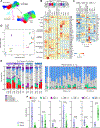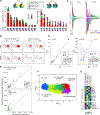ZNF683 marks a CD8+ T cell population associated with anti-tumor immunity following anti-PD-1 therapy for Richter syndrome
- PMID: 37738974
- PMCID: PMC10618915
- DOI: 10.1016/j.ccell.2023.08.013
ZNF683 marks a CD8+ T cell population associated with anti-tumor immunity following anti-PD-1 therapy for Richter syndrome
Abstract
Unlike many other hematologic malignancies, Richter syndrome (RS), an aggressive B cell lymphoma originating from indolent chronic lymphocytic leukemia, is responsive to PD-1 blockade. To discover the determinants of response, we analyze single-cell transcriptome data generated from 17 bone marrow samples longitudinally collected from 6 patients with RS. Response is associated with intermediate exhausted CD8 effector/effector memory T cells marked by high expression of the transcription factor ZNF683, determined to be evolving from stem-like memory cells and divergent from terminally exhausted cells. This signature overlaps with that of tumor-infiltrating populations from anti-PD-1 responsive solid tumors. ZNF683 is found to directly target key T cell genes (TCF7, LMO2, CD69) and impact pathways of T cell cytotoxicity and activation. Analysis of pre-treatment peripheral blood from 10 independent patients with RS treated with anti-PD-1, as well as patients with solid tumors treated with anti-PD-1, supports an association of ZNF683high T cells with response.
Keywords: Hobit; PD-1; Richter transformation; ZNF683; checkpoint blockade; chronic lymphocytic leukemia; immunotherapy; single-cell RNA sequencing; t cells; tox.
Copyright © 2023 Elsevier Inc. All rights reserved.
Conflict of interest statement
Declaration of interests C.J.W. receives funding support from: Pharmacyclics; holds equity in: BioNTech, Inc; G.G. is a founder, consultant and holds privately held equity in Scorpion Therapeutics, receives funding support from: IBM and Pharmacyclics, is an inventor on patent applications related to: MuTect, ABSOLUTE, MutSig, MSMuTect, MSMutSig, MSIDetect, POLYSOLVER, and TensorQTL; R.G. receives funding support from: Abbvie, Janssen, Gilead, AstraZeneca, and Roche; N.J. receives research funding from: Pharmacyclics, AbbVie, Genentech, AstraZeneca, BMS, Pfizer, Servier, ADC Therapeutics, Cellectis, Precision BioSciences, Adaptive Biotechnologies, Incyte, Aprea Therapeutics, Fate Therapeutics, Mingsight, Takeda, Medisix, Loxo Oncology, Novalgen and serves on Advisory Board/Honoraria: Pharmacyclics, Janssen, AbbVie, Genentech, AstraZeneca, BMS, Adaptive Biotechnologies, Precision BioSciences, Servier, Beigene, Cellectis, TG Therapeutics, ADC Therapeutics, MEI Pharma; W.G.W. reports funding from GSK/Novartis, Abbvie, Genentech, Pharmacyclics LLC, AstraZeneca/Acerta Pharma, Gilead Sciences, Juno Therapeutics, KITE Pharma, Sunesis, Miragen, Oncternal Therapeutics, Inc., Cyclacel, Loxo Oncology, Inc., Janssen, Xencor. B.A.K., C.J.W. and G.G. are inventors on patent: “Compositions, panels, and methods for characterizing chronic lymphocytic leukemia” (PCT/US21/45144); S.A.S. reports nonfinancial support from Bristol-Myers Squibb, and equity in Agenus Inc., Agios Pharmaceuticals, Breakbio Corp., Bristol-Myers Squibb and Lumos Pharma. N.P. is currently an employee of Bristol Myers Squibb. K.J.L. holds equity in Standard BioTools Inc. (formerly Fluidigm Corporation). C.J.W. and E.M.P are inventors on a patent, US Utility Application No. US-2022-0298580-A1 filed on 02/10/2022, International Application No. WO/2021/041669 filed on 9/15/2022, “Immune Signatures Predictive of Response to PD-1 Blockade in Richter’s transformation.” M.D., J.D.K. and B.T. have no relevant conflict of interest. C.T. reports honorarium from Beigene, Janssen, Abbvie, AZ and LOXO and research funding from Beigene, Janssen, and AbbVie.
Figures







References
-
- Jain N, Senapati J, Thakral B, Ferrajoli A, Thompson PA, Burger JA, Basu S, Kadia TM, Daver NG, Borthakur G, et al. (2022). A Phase 2 Study of Nivolumab Combined with Ibrutinib in Patients with Diffuse Large B-cell Richter Transformation of CLL. Blood Adv, bloodadvances.2022008790. 10.1182/bloodadvances.2022008790. - DOI - PMC - PubMed
-
- Younes A, Brody J, Carpio C, Lopez-Guillermo A, Ben-Yehuda D, Ferhanoglu B, Nagler A, Ozcan M, Avivi I, Bosch F, et al. (2019). Safety and activity of ibrutinib in combination with nivolumab in patients with relapsed non-Hodgkin lymphoma or chronic lymphocytic leukaemia: a phase 1/2a study. Lancet Haematol. 6, e67–e78. 10.1016/S2352-3026(18)30217-5. - DOI - PubMed
Publication types
MeSH terms
Grants and funding
LinkOut - more resources
Full Text Sources
Molecular Biology Databases
Research Materials

